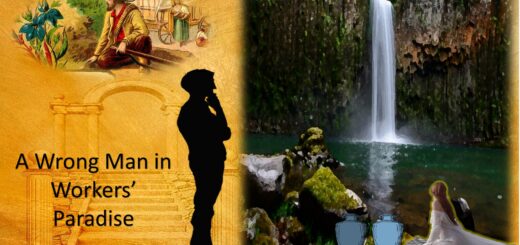The elixir of life by C V Raman – Kannada Summary
The Elixir of Life (a magical or medicinal potion) – ಜೀವನದ ಅಮೃತ
Notes
Summary
Man has through the ages tried in vain for an imaginary elixir of life, the divine amrita, to confer immortality (the ability to live forever). But the true elixir of life lies near to our hands, for it is the commonest of all liquids, plain water!
ಯುಗಯುಗಗಳಿಂದ ಮನುಷ್ಯನು ಮರಣವನ್ನು ಜಯಿಸಿ, ಅಮರತ್ವವ ಕಾಲ್ಪನಿಕ ಅಮೃತಕ್ಕಾಗಿ, ವ್ಯರ್ಥ ಪ್ರಯತ್ನಗಳನ್ನು ಮಾಡುತ್ತಿದ್ದಾನೆ. ಆದರೆ ನಿಜವಾದ ಜೀವನಾಮೃತವು ನಮ್ಮ ಕೈಗಳಿಗೆ ಎಟಕುವಂತೆಯೇ ಇದೆ, ಅದು ಅತಿ ಸಾಮಾನ್ಯವಾಗಿ ಸಿಗುವ ದ್ರವ, ನೀರು !
I remember one day standing on the line which separates the Libyan Desert from the Valley of the Nile in Egypt. On one side was visible a sea of billowing sand without a speck of green or a single living thing anywhere visible on it while on the other side lay one of the greenest, most fertile, and densely populated areas to be found anywhere on the earth, teeming with life and vegetation. What made this wonderful difference? Why? it is the water of the River Nile flowing down to the Mediterranean from its sources a couple of thousands of miles away.
ಈಜಿಪ್ಟ್ನ ನೈಲ್ ಕಣಿವೆಯಿಂದ ಲಿಬಿಯಾ ಮರುಭೂಮಿಯನ್ನು ಬೇರ್ಪಡಿಸುವ ದಾರಿಯಲ್ಲಿ ನಿಂತ ಆ ಒಂದು ದಿನ, ನನಗೆ ಚೆನ್ನಾಗಿ ನೆನಪಿದೆ. ಒಂದು ಕಡೆ ಒಂದು ಚುಕ್ಕಿಯಷ್ಟೂ ಹಸಿರಿಲ್ಲದ, ಯಾವುದೇ ಜೀವಿಯ ಕುರುಹೇ ಇಲ್ಲದ ಸಮುದ್ರದಂತೆ ಮೊರೆಯುವ ಮರಳಿನ ಅಲೆಗಳು , ಮತ್ತೊಂದು ಪಕ್ಕದಲ್ಲಿ ಹಚ್ಚಹಸುರಿನ, ಫಲವತ್ತಾದ ಮತ್ತು ಪ್ರಪಂಚದ ಅತಿ ಹೆಚ್ಚು ಜನನಿಬಿಡ ಪ್ರದೇಶಗಳು ಕಂಡುಬರುತ್ತವೆ. ಇಂತಹ ಅದ್ಬುತ ವೈಪರೀತ್ಯವನ್ನು ಅದಾವ ಶಕ್ತಿಯು ಸೃಷ್ಟಿಸಿದೆ? ಯಾಕಾಗಿ ಮಾಡಿದೆ? ಇದು ಒಂದೆರಡು ಸಾವಿರ
ಮೈಲಿ ದೂರದ ಮೂಲಗಳಿಂದ ಮೆಡಿಟರೇನಿಯನ್ಗೆ ಹರಿದು ಬರುವ ನೈಲ್ ನದಿಯಿಂದ ಅದ ಚಮತ್ಕಾರ.
Geologists tell us that the entire soil of the Nile valley is the creation of the river itself. It was brought down as the finest silt in its floodwaters, from the highlands of Abyssinia and from remote Central Africa, and laid down through the ages in the trough through which the Nile flows into the sea. Egypt, in fact, was made by its river. Its ancient civilization was created and is sustained by the life-giving waters which come down year after year with unfailing regularity.
ನೈಲ್ ಕಣಿವೆಯ ಮಣ್ಣಿನ ಸಂಪೂರ್ಣ ಸೃಷ್ಟಿಯು ನೈಲ್ ನದಿಯಿಂದಲೇ ಆಗಿರುವುದು ಎಂದು ಭೂವಿಜ್ಞಾನಿಗಳು ಹೇಳುತ್ತಾರೆ. ಅಬಿಸ್ಸಿನಿಯಾದ ಎತ್ತರದ ಪ್ರದೇಶಗಳಿಂದ ಮತ್ತು ದೂರದ ಮಧ್ಯ ಆಫ್ರಿಕಾದಿಂದ ಹರಿಯುವ ಈ ನದಿಯ ಪ್ರವಾಹದ ನೀರಿನಲ್ಲಿ ಕೊಚ್ಚಿಕೊಂಡು ಬಂದ ಅತ್ಯುತ್ತಮವಾದ ಹೂಳು, ಸಮುದ್ರಕ್ಕೆ ಹರಿಯುವ ಮುಂಚಿನ ಹಳ್ಳಗಳಲ್ಲಿ ವರ್ಷಾನುವರ್ಷಗಳಿಂದ ಸಂಗ್ರಹವಾಗಿದೆ. ವಾಸ್ತವವಾಗಿ ನೈಲ್ ನದಿಯಿಂದಲೇ ಈಜಿಪ್ಟ್ ರೂಪುಗೊಂಡಿದೆ. ವರ್ಷದಿಂದ ವರ್ಷಕ್ಕೆ ನಿರಂತರವಾಗಿ ಕೆಳಗೆ ಇಳಿದು ಬರುವ ಈ ಜೀವನದಿಯು ಈ ಪ್ರಾಚೀನ ನಾಗರಿಕತೆಗೆ ಜನ್ಮ ನೀಡಿ ಅದನ್ನು ಸಂರಕ್ಷಿಸಿದೆ.
I give this example and could give many others to emphasize that this common substance which we take for granted in our everyday life is the most potent and the most wonderful thing on the face of our earth. It has played a role of vast significance in shaping the course of the earth’s history and continues to play the leading role in the drama of life on the surface of our planet.
ನಾನು ಇಂತಹದೇ ಇನ್ನಷ್ಟು ಉದಾಹರಣೆ ಕೊಟ್ಟು ಹೇಳಬಹುದು, ನಮ್ಮ ದೈನಂದಿನ ಜೀವನದಲ್ಲಿ ನಾವು ಸುಲಭಕ್ಕೆ ತೆಗೆದುಕೊಳ್ಳುವ ಈ ಸಾಮಾನ್ಯ ವಸ್ತುವು ನಮ್ಮ ಭೂಮಿಯ ಮೇಲಿನ ಅತ್ಯಂತ ಶಕ್ತಿಯುತ ಮತ್ತು ಅದ್ಭುತವಾದ ವಸ್ತು ಎಂದು. ಇದು ಭೂಮಿಯ ಇತಿಹಾಸದ ಹಾದಿಯನ್ನು ರೂಪಿಸುವಲ್ಲಿ ಅಪಾರ ಮಹತ್ವದ ಪಾತ್ರವನ್ನು ವಹಿಸಿದೆ ಮತ್ತು ನಮ್ಮ ಗ್ರಹದ ಮೇಲ್ಮೈಯಲ್ಲಿ ನಡೆಯುವ ಪ್ರತಿಯೊಂದು ಜೀವಿಗಳ ಜೀವನ ನಾಟಕದಲ್ಲಿ ಇಂದಿಗೂ ಕೂಡ ಪ್ರಮುಖ ಪಾತ್ರ ವಹಿಸುತ್ತಿದೆ.
There is nothing which adds so much to the beauty of the countryside as water, be it just a little stream trickling over the rocks or a little pond by the wayside where the cattle quench their thirst of an evening. The rain-fed tanks that are so common in South India-alas often so sadly neglected in their maintenance-are a cheering sight when they are full. They are, of course, shallow, but this is less evident since the water is silt-laden and throws the light back, and the bottom does not, therefore, show up. These tanks play a vital role in South Indian agriculture. Some of these tanks are surprisingly large and it is a beautiful sight to see the sunrise or set over one of them. Water in a landscape may be compared to the eyes in a human face. It reflects the mood of the hour, being bright and gay when the sun shines, turning to dark and gloomy when the sky is overcast.
ಗ್ರಾಮೀಣ ಪ್ರದೇಶದ ಸೌಂದರ್ಯವನ್ನು ನೀರು ಹೆಚ್ಚಿಸುವ ಹಾಗೆ ಬೇರೆ ಯಾವುದೂ ಇಲ್ಲ. ಅದು ಬಂಡೆಗಳ ಮೇಲೆ ಹೊಳೆಯುವ ಸಣ್ಣ ಝರಿಯೇ ಆಗಿರಲಿ ಅಥವಾ ದನಕರುಗಳ ಸಂಜೆಯ ಬಾಯಾರಿಕೆಯನ್ನು ತಣಿಸುವ ದಾರಿ ಪಕ್ಕದ ಪುಟ್ಟ ಕೊಳವೇ ಆಗಿರಲಿ. ದಕ್ಷಿಣ ಭಾರತದಲ್ಲಿ ಸಾಮಾನ್ಯವಾಗಿ ಕಂಡುಬರುವ ಮಳೆಯಾಶ್ರಿತ ಕೆರೆಗಳು – ಆಗಾಗ್ಗೆ ಅವುಗಳ ನಿರ್ವಹಣೆಯಲ್ಲಿ ನಿರ್ಲಕ್ಷ್ಯ ಇರಬಹುದು. ಆದರೂ ಅವು ತುಂಬಿರುವಾಗ ಅದು ಮನಸಿಗೆ ಉಲ್ಲಾಸ ನೀಡುವ ದೃಶ್ಯ. ಅವು ಸಹಜವಾಗಿ ಆಳವಿಲ್ಲದೆ ಇರವಂತಹವು, ಅವುಗಳ ನೀರು ಹೂಳು ತುಂಬಿರುವುದರಿಂದ ಮತ್ತು ಬೆಳಕನ್ನು ಪ್ರತಿಫಲಿಸುವುದರಿಂದ, ಕೆರೆಗಳ ಆಳವು ಸ್ಪಷ್ಟವಾಗಿ ಕಾಣಿಸುವುದಿಲ್ಲ. ಈ ಕೆರೆಗಳು ದಕ್ಷಿಣ ಭಾರತದ ಕೃಷಿಯಲ್ಲಿ ಪ್ರಮುಖ ಪಾತ್ರವನ್ನು ವಹಿಸುತ್ತವೆ. ಆಶ್ಚರ್ಯಕರವಾಗಿ ಕೆಲವು ಕೆರೆಗಳು ದೊಡ್ಡದಾಗಿವೆ ಮತ್ತು ಅಲ್ಲಿ ಸೂರ್ಯೋದಯ ಅಥವಾ ಸೂರ್ಯಾಸ್ತವನ್ನು ನೋಡುವುದು ಒಂದು ಸುಂದರ ದೃಶ್ಯವಾಗಿರುತ್ತದೆ. ಭೂಮಿತಾಯಿಯ ಮೇಲಿನ ನೀರನ್ನು, ಮಾನವನ ಮುಖದ ಮೇಲಿನ ಕಣ್ಣುಗಳಿಗೆ ಹೋಲಿಸಬಹುದು. ಇದು ಸಮಯದ ಮನಸ್ಥಿತಿಯನ್ನು ಪ್ರತಿಬಿಂಬಿಸುತ್ತವಂತೆ ಕಾಣಿಸುತ್ತದೆ, ಸೂರ್ಯನು ಬೆಳಗಿದಾಗ ಪ್ರಕಾಶಮಾನವಾಗಿ ಮತ್ತು ಉಲ್ಲಾಸಕರವಾಗಿರುತ್ತದೆ, ಆಗಸದಲ್ಲಿ ಕತ್ತಲೆಯಾದಾಗ ಇದಕ್ಕೂ ಸಹ ಮಸುಕು ಕವಿಯುತ್ತದೆ.
One of the most remarkable facts about water is its power to carry silt or finely-divided soil in suspension. This is the origin of the characteristic color of the water in rain-fed tanks. This color varies with the nature of the earth in the catchment area and is most vivid immediately after a fresh inflow following rain. Swiftly flowing water can carry fairly large and heavy particles. The finest particles, however, remain floating within the liquid in spite of their greater density and are, of course, extremely small, but their number is also great.
ನೀರಿನ ಬಗ್ಗೆ ಅತ್ಯಂತ ಗಮನಾರ್ಹವಾದ ಸಂಗತಿಯೆಂದರೆ ಹೂಳು ಅಥವಾ ನುಣ್ಣಗೆ ಸಡಿಲವಾಗಿರುವ ಮಣ್ಣನ್ನು ಸಾಗಿಸುವ ಶಕ್ತಿ. ಮಳೆಯಾಶ್ರಿತ ಕೆರೆಗಳಲ್ಲಿನ ನೀರಿನ ವಿಶಿಷ್ಟವಾದ ಬಣ್ಣಕ್ಕೆ ಇದು ಮೂಲವಾಗಿದೆ. ಈ ಬಣ್ಣವು ಜಲಾನಯನ ಪ್ರದೇಶದಲ್ಲಿನ ಭೂಮಿಯ ಸ್ವರೂಪದೊಂದಿಗೆ ಬದಲಾಗುತ್ತದೆ ಮತ್ತು ಮಳೆಯ ಸಂಧರ್ಭದಲ್ಲಿ ಹೊಸ ಒಳಹರಿವಿನ ನಂತರ ಹೆಚ್ಚು ಎದ್ದುಕಾಣುತ್ತದೆ. ವೇಗವಾಗಿ ಹರಿಯುವ ನೀರು ಸಾಕಷ್ಟು ದೊಡ್ಡ ಮತ್ತು ಭಾರವಾದ ಕಣಗಳನ್ನು ಒಯ್ಯಬಲ್ಲದು. ಆದಾಗ್ಯೂ, ಸೂಕ್ಷ್ಮ ಕಣಗಳು ಹೆಚ್ಚಿನ ಸಾಂದ್ರತೆಯ ನಡುವೆಯೂ ನೀರಿನೊಳಗೆಯೇ ತೇಲುತ್ತವೆ. ಅವುಗಳು ಬಹಳ ಚಿಕ್ಕದಾಗಿದ್ದರೂ, ಸಂಖ್ಯೆಯಲ್ಲಿ ಜಾಸ್ತಿಯಿರುತ್ತದೆ.
The flow of water has undoubtedly played a great part and a beneficent one in the geological processes by which the soil on the earth’s surface has been formed from the rocks of its crust. The same agency, however, under appropriate conditions, can also play a destructive part and wash away the soil which is the foundation of all agriculture, and if allowed to proceed unchecked can have the most disastrous effects on the life of the country. The problem of soil erosion is one of serious import in various countries and especially in many parts of India. The conditions under which it occurs and the measures by which it can be checked deserve the closest study.
ನೀರಿನ ಹರಿವು ಭೌಗೋಳಿಕ ಪ್ರಕ್ರಿಯೆಗಳಲ್ಲಿ ನಿಸ್ಸಂದೇಹವಾಗಿ ಒಂದು ದೊಡ್ಡ ಪಾತ್ರವನ್ನು ವಹಿಸಿದೆ ಮತ್ತು ಭೂಮಿಯ ಮೇಲ್ಮೈಯಲ್ಲಿರುವ ಮಣ್ಣು ನೆಲದ ಹೊರಪದರದ ಬಂಡೆಗಳಿಂದ ರೂಪುಗೊಂಡಿದೆ. ಅದೇ ಶಕ್ತಿಯು ಸೂಕ್ತ ಪರಿಸ್ಥಿತಿಗಳಲ್ಲಿ, ವಿನಾಶಕಾರಿ ಪಾತ್ರವನ್ನು ವಹಿಸುತ್ತದೆ ಮತ್ತು ಎಲ್ಲಾ ಕೃಷಿಯ ಅಡಿಪಾಯವಾಗಿರುವ ಮಣ್ಣನ್ನು ಕೊಚ್ಚಿಕೊಂಡು ಹೋಗುತ್ತದೆ. ಸೂಕ್ತ ಎಚ್ಚರಿಕೆ ತೆಗೆದುಕೊಳ್ಳದೆ ಹೋದರೆ, ದೇಶದ ಜೀವನದ ಮೇಲೆ ಅತ್ಯಂತ ಹಾನಿಕಾರಕ ಪರಿಣಾಮಗಳನ್ನು ಬೀರುತ್ತದೆ. ಮಣ್ಣಿನ ಸವೆತದ ಸಮಸ್ಯೆ ವಿವಿಧ ದೇಶಗಳಲ್ಲಿ ಮತ್ತು ವಿಶೇಷವಾಗಿ ಭಾರತದ ಅನೇಕ ಭಾಗಗಳಲ್ಲಿ ಬಹಳವೇ ಗಂಭೀರವಾಗಿದೆ. ಅದು ಯಾವ ಪರಿಸ್ಥಿತಿಗಳಲ್ಲಿ ಸಂಭವಿಸುತ್ತದೆ ಮತ್ತು ಅದನ್ನು ತಡೆಯಲು ತಗೆದುಕೊಳ್ಳಬೇಕಾದ ಕ್ರಮಗಳು ಏನು , ಎಂಬುದು ಹೆಚ್ಚಿನ ಅಧ್ಯಯನಕ್ಕೆ ಖಂಡಿತವಾಗಿಯೂ ಅರ್ಹವಾಗಿವೆ.
Soil erosion occurs in successive steps, the earliest of which may easily pass unnoticed. In the later stages, the cutting up and washing away of the earth is only too painfully apparent in the formation of deep gullies and ravines which make all agriculture impossible. Sudden bursts of excessively heavy rain resulting in a large runoff of surplus water are the principal factors in causing soil erosion. Contributory causes are the slope of the land, removal of the natural protective coat of vegetation, the existence of ruts along which the water can flow with rapidly gathering momentum, and the absence of any checks to such flow. Incredibly large quantities of precious soil can be washed away if such conditions exist, as is unhappily too often the case.
ಮಣ್ಣಿನ ಸವಕಳಿಯು ಸತತ ಹಂತಗಳಲ್ಲಿ ಸಂಭವಿಸುತ್ತದೆ, ಪ್ರಾರಂಭಿಕ ಹಂತಗಳಲ್ಲಿ ಸುಲಭವಾಗಿ ಗಮನಕ್ಕೆ ಬಾರದೆ ಹೋಗಬಹುದು. ಆದರೆ ನಂತರದ ಹಂತಗಳಲ್ಲಿ, ಭೂಮಿಯನ್ನು ಕತ್ತರಿಸುವುದು ಮತ್ತು ಸವೆಸುವುದು, ನೆಲವು ಆಳವಾದ ಗಲ್ಲಿಗಳು ಮತ್ತು ಕಂದರಗಳಾಗಿ ಬದಲಾಗಿ, ಬಹಳವೇ ಕಷ್ಟಕರವಾದ ಸನಿವೇಶ ಸೃಷ್ಟಿಯಾಗುತ್ತದೆ, ಅದು ಯಾವುದೇ ತರಹದ ಕೃಷಿಯನ್ನು ಅಸಾಧ್ಯವಾಗಿಸುತ್ತದೆ. ಹಠಾತ್ ಆಗಿ ಸುರಿಯುವ ಅತಿಯಾದ ಜಡಿ ಮಳೆಗಳು, ಪ್ರವಾಹದ ನೀರಿನ ಹೆಚ್ಚುವರಿ ಹರಿವು ಮಣ್ಣಿನ ಸವೆತಕ್ಕೆ ಕಾರಣವಾಗುವ ಪ್ರಮುಖ ಅಂಶಗಳಾಗಿವೆ. ಭೂಮಿಯ ಇಳಿಜಾರು, ನೈಸರ್ಗಿಕ ಸಸ್ಯಗಳ ಕವಚದ ನಾಶ, ನೀರು ಇನ್ನಷ್ಟು ವೇಗವಾಗಿ ಹರಿಯಲು ಅನುಕೂಲ ಮಾಡಿಕೊಡುವ ಕಂದಕಗಳು, ಮತ್ತು ಅಂತಹ ಹರಿವಿಗೆ ಯಾವುದೇ ತಡೆ ಇಲ್ಲದಿರುವುದು ಇದಕ್ಕೆ ಕಾರಣಗಳಾಗಿವೆ. ಅಂತಹ ಪರಿಸ್ಥಿತಿಗಳು ಹಾಗೆಯೆ ಮುಂದುವರಿದರೆ ನಂಬಲಾಗದಷ್ಟು ದೊಡ್ಡ ಪ್ರಮಾಣದ ಅಮೂಲ್ಯವಾದ ಮಣ್ಣು ಕೊಚ್ಚಿ ಹೋಗಬಹುದು, ಮತ್ತು ಅದು ಆಗೀಗ ಸಂಭವಿಸುತ್ತಲೇ ಇರುತ್ತದೆ.
The menace which soil erosion presents to the continuance of successful agriculture is an alarming one in many parts of India, calling urgently for attention and preventive action. The terracing of the land, the construction of bunds to check the flow of water, the practice of contour cultivation, and the planting of appropriate types of vegetation are amongst the measures that have been suggested. It is obvious that the aim should be to check the flow of water at the earliest possible stage before it has acquired any appreciable momentum and correspondingly large destructive power.
ಯಶಸ್ವಿ ಕೃಷಿಯ ಮುಂದುವರಿಕೆಗೆ ಮಣ್ಣಿನ ಸವೆತವು ಉಂಟುಮಾಡುವ ವಿಪತ್ತು ಭಾರತದ ಅನೇಕ ಭಾಗಗಳಲ್ಲಿ ಆತಂಕಕಾರಿಯಾಗಿದೆ, ತುರ್ತಾದ ಗಮನ ಮತ್ತು ತಡೆಗಟ್ಟುವ ಕ್ರಮಗಳ ಅವಶ್ಯಕತೆ ಇದೆ. ನೀರಿನ ಹರಿವನ್ನು ನಿಯಂತ್ರಿಸಲು ಸೂಚಿಸಿದ ಕ್ರಮಗಳಲ್ಲಿ ಭೂಮಿಯ ಟೆರೇಸಿಂಗ್ (ಮೆಟ್ಟಿಲುಪಾತಿ) ಕೃಷಿ ಪದ್ದತಿ, ಕಟ್ಟುಗಳ ನಿರ್ಮಾಣ, ಕಾಂಟೂರ್ ಕೃಷಿಯ ಅಭ್ಯಾಸ ಮತ್ತು ಸೂಕ್ತ ರೀತಿಯ ಸಸ್ಯಗಳನ್ನು ನೆಡುವುದು ಸೇರಿವೆ. ಇದರ ಉದ್ದೇಶ ನೀರಿನ ಹರಿವು ಅತಿ ಹೆಚ್ಚಿನ ವೇಗವನ್ನು ಪಡೆದುಕೊಂಡು ದೊಡ್ಡ ವಿನಾಶಕಾರಿ ಶಕ್ತಿಯಾಗಿ ಬದಲಾಗುವ ಮುನ್ನವೇ, ಆರಂಭಿಕ ಹಂತದಲ್ಲಿಯೇ ತಡೆಯುವುದಾಗಿದೆ.
Water is the basis of all life. Every animal and every plant contains a substantial proportion of free or combined water in its body, and no kind of physiological activity is possible in which the fluid does not play an essential part. Water is, of course, necessary for animal life, while moisture in the soil is equally imperative for the life and growth of plants and trees. The preservation and utilization of water are thus fundamental for human welfare.
ನೀರು ಎಲ್ಲಾ ಜೀವಗಳಿಗೆ ಆಧಾರವಾಗಿದೆ. ಪ್ರತಿಯೊಂದು ಪ್ರಾಣಿ ಮತ್ತು ಸಸ್ಯವು ಅದರ ದೇಹದಲ್ಲಿ ಗಣನೀಯ ಪ್ರಮಾಣದಲ್ಲಿ ಸಹಜ ಅಥವಾ ಸಂಯೋಜಿತ ನೀರನ್ನು ಹೊಂದಿರುತ್ತದೆ, ನೀರಿಲ್ಲದೆ ಯಾವುದೇ ರೀತಿಯ ದೈಹಿಕ ಚಟುವಟಿಕೆಯು ಸಾಧ್ಯವಿಲ್ಲ, ಇದರಲ್ಲಿ ದ್ರವವು ಮುಖ್ಯವಾದ ಪಾತ್ರವನ್ನು ವಹಿಸುವುತ್ತದೆ. ಪ್ರಾಣಿಗಳ ಜೀವನಕ್ಕೆ ನೀರು ಅವಶ್ಯಕವಾಗಿದೆ, ಆದರೆ ಮಣ್ಣಿನಲ್ಲಿನ ತೇವಾಂಶವು ಸಸ್ಯಗಳು ಮತ್ತು ಮರಗಳ ಜೀವನ ಹಾಗು ಬೆಳವಣಿಗೆಗೆ ಅಷ್ಟೇ ಅತ್ಯಗತ್ಯವಾದ ಅಂಶವಾಗಿದೆ. ನೀರಿನ ಸಂರಕ್ಷಣೆ ಮತ್ತು ಬಳಕೆ ಮಾನವ ಕಲ್ಯಾಣಕ್ಕೆ ಮೂಲಭೂತವಾಗಿದೆ.
Apart from artesian water (An artesian well is simply a well that doesn’t require a pump to bring water to the surface; this occurs when there is enough pressure in the aquifer. The pressure forces the water to the surface without any sort of assistance. An aquifer is a geologic layer of permeable and porous rock such as sandstone or limestone and that provides the water source for the artesian well.
ಆರ್ಟೇಶಿಯನ್ ನೀರಿನ (ಆರ್ಟೇಶಿಯನ್ ಅಥವಾ ಅಂತರ್ಜಲದ ಬಾವಿ ನೈಸರ್ಗಿಕ ಬಾವಿಯಾಗಿದ್ದು ಅದರ ನೀರನ್ನು ಮೇಲೆ ತರಲು ಯಾವುದೇ ಪಂಪ್ ನ ಅಗತ್ಯವಿಲ್ಲ; ಅಂತರ್ಜಲದಲ್ಲಿ ಸಾಕಷ್ಟು ಒತ್ತಡ ಇದ್ದಾಗ ಇದು ತಾನಾಗಿಯೇ ಸಂಭವಿಸುತ್ತದೆ. ಈ ನೀರಿನ ಒತ್ತಡವು, ಯಾವುದೇ ರೀತಿಯ ಸಹಾಯವಿಲ್ಲದೆ ನೀರನ್ನು ಭೂಮಿಯ ಮೇಲ್ಭಾಗಕ್ಕೆ ತಳ್ಳುತ್ತದೆ. ಅಕ್ವಿಫರ್ – ಮರಳುಗಲ್ಲು ಅಥವಾ ಸುಣ್ಣದ ಕಲ್ಲುಗಳಂತಹ ನೀರು ತೂರಿ ಹೋಗಲು ಸಾಧ್ಯವಿರುವ ಮತ್ತು ರಂಧ್ರಗಳು ಇರುವ ಬಂಡೆಯ ಭೌಗೋಳಿಕ ಪದರವಾಗಿದೆ ಮತ್ತು ಇದು ಆರ್ಟೇಶಿಯನ್ ಬಾವಿಗೆ ನೀರಿನ ಮೂಲವನ್ನು ಒದಗಿಸುತ್ತದೆ.
The aquifer absorbs and stores water and in an artesian well, the porous stone is sandwiched between a top and bottom layer of impermeable rock such as shale or clay. This causes positive pressure.), the ultimate source in all cases is rain or snowfall. Much of Indian agriculture depends on seasonal rainfall and is therefore very sensitive to any failure or irregularity of the same. The problems of soil erosion and inadequate or irregular rainfall are closely connected with each other. It is clear that the adoption of techniques preventing soil erosion would also help to conserve and keep the water where it is wanted, in other words, on and in the soil, and such techniques, therefore, serve a double purpose.
ಈ ಬಂಡೆಗಳು ನೀರನ್ನು ಹೀರಿಕೊಂಡು ಸಂಗ್ರಹಿಸುತ್ತದೆ. ಆರ್ಟೇಶಿಯನ್ ಬಾವಿಯಲ್ಲಿ ಹೀರಿಕೊಂಡ ನೀರು ಜಿನುಜಿ ಹೋಗಲು ಸಾಧ್ಯವಾಗದ ಹಾಗೆ ಈ ಸರಂಧ್ರ ಕಲ್ಲುಗಳು, ಶೇಲ್(ಜೇಡಿಪದರಗಲ್ಲು) ಅಥವಾ ಜೇಡಿಮಣ್ಣಿನಂತಹ ನೀರು ತೂರಿಕೊಳ್ಳಲು ಸಾಧ್ಯವಾಗದ ಬಂಡೆಯ ಮೇಲಿನ ಮತ್ತು ಕೆಳಗಿನ ಪದರದ ನಡುವೆ ಸಿಕ್ಕಿಹಾಕಿಕೊಂಡಿರುತ್ತದೆ. ಇದು ಸಕಾರಾತ್ಮಕ ಒತ್ತಡಕ್ಕೆ ಕಾರಣವಾಗುತ್ತದೆ.) ಇದರ ಹೊರತಾಗಿ ಎಲ್ಲಾ ಸಂದರ್ಭಗಳಲ್ಲಿ ನೀರಿನ ಅಂತಿಮ ಮೂಲವೆಂದರೆ ಮಳೆ ಅಥವಾ ಹಿಮಪಾತ. ಭಾರತೀಯ ಕೃಷಿಯ ಬಹುಪಾಲು ಮಳೆಗಾಲದ ಮಳೆಯ ಮೇಲೆ ಅವಲಂಬಿತವಾಗಿರುತ್ತದೆ. ಆದ್ದರಿಂದ ಮಳೆಯು ಸ್ವಲ್ಪ ಹೆಚ್ಚು ಕಡಿಮೆಯಾದರೂ ಸಹ ಕೃಷಿಯು ಸುಲಭವಾಗಿ ಸಂಕಷ್ಟಕ್ಕೆ ಸಿಲುಕಿಕೊಳ್ಳುತ್ತದೆ. ಮಣ್ಣಿನ ಸವೆತ, ಬಂಜರುತನ ಹಾಗು ಅಡ್ಡಾದಿಡ್ಡಿ ಮಳೆಯ ಸಮಸ್ಯೆಗಳು ಪರಸ್ಪರ ಸಂಬಂಧ ಹೊಂದಿವೆ. ಮಣ್ಣಿನ ಸವೆತವನ್ನು ತಡೆಗಟ್ಟುವ ತಂತ್ರಗಳನ್ನು ಅಳವಡಿಸಿಕೊಳ್ಳುವುದರಿಂದ, ನೀರನ್ನು ಬೇಕಾದ ಕಡೆ ಸಂಗ್ರಹಿಸಲು, ಅಂದರೆ ಮಣ್ಣಿನ ಮೇಲೆ ಹಾಗು ಒಳಗೆ ಉಳಿಸಿಕೊಳ್ಳಲು ಸಹಾಯ ಮಾಡುತ್ತದೆ ಎಂಬುದು ಸ್ಪಷ್ಟವಾಗಿದೆ. ಆದ್ದರಿಂದ ಅಂತಹ ತಂತ್ರಗಳು ಎರಡು ಉದ್ದೇಶಗಳನ್ನೂ ಪೂರೈಸುತ್ತವೆ.
It is evident however that in a country having only a seasonal rainfall an immense quantity of rainwater must necessarily run off the ground. The collection and utilization of this water are, therefore, of vital importance. Much of it flows down into the streams and rivers and ultimately finds its way to the sea. Incredibly large quantities of the precious fluid are thus lost to the country. The harnessing of our rivers, the waters of which now mostly run to waste, is a great national problem which must be considered and dealt with on national lines. Vast areas of land which at present are mere scrub jungle could be turned into a fertile and prosperous country by courageous and well-planned action.
ಮಳೆಗಾಲದ ಮಳೆ ಮಾತ್ರ ಇರುವ ದೇಶದಲ್ಲಿ ಅಪಾರ ಪ್ರಮಾಣದ ಮಳೆನೀರು ನೆಲದ ಮೇಲೆಯೇ ಹರಿಯಬೇಕು ಎಂಬುದು ಸ್ಪಷ್ಟವಾಗಿದೆ. ಆದ್ದರಿಂದ ಈ ನೀರಿನ ಸಂಗ್ರಹ ಮತ್ತು ಬಳಕೆ ಬಹಳ ಮಹತ್ವದ್ದಾಗಿದೆ. ಅದರಲ್ಲಿ ಹೆಚ್ಚಿನವು ಹೊಳೆಗಳು ಮತ್ತು ನದಿಗಳಲ್ಲಿ ಹರಿಯುತ್ತದೆ ಮತ್ತು ಅಂತಿಮವಾಗಿ ಸಮುದ್ರಕ್ಕೆ ಹೋಗುವ ದಾರಿಯನ್ನು ಕಂಡುಕೊಳ್ಳುತ್ತದೆ. ನಂಬಲಾಗದಷ್ಟು ದೊಡ್ಡ ಪ್ರಮಾಣದ ಅಮೂಲ್ಯ ದ್ರವವನ್ನು ಹೀಗೆ ದೇಶವು ಕಳೆದುಕೊಳ್ಳುತ್ತದೆ. ಈಗ ಅತಿಯಾಗಿ ವ್ಯರ್ಥವಾಗುತ್ತಿರುವ ನದಿ ನೀರಿನ ಸಂಗ್ರಹ ಮಾಡುವುದು ಒಂದು ದೊಡ್ಡ ರಾಷ್ಟ್ರೀಯ ಸಮಸ್ಯೆಯಾಗಿದ್ದು, ಇದನ್ನು ರಾಷ್ಟ್ರೀಯ ಮಟ್ಟದಲ್ಲಿಯೇ ಪರಿಗಣಿಸಬೇಕು ಮತ್ತು ವ್ಯವಹರಿಸಬೇಕು. ಪ್ರಸ್ತುತ ಕೇವಲ ಕುರುಚಲು ಕಾಡುಗಳಾಗಿರುವ ವಿಶಾಲವಾದ ಪ್ರದೇಶಗಳನ್ನು ದೃಢ ಸಂಕಲ್ಪದಿಂದ ಮತ್ತು ಸರಿಯಾದ ಯೋಜಿತ ಕ್ರಮಗಳಿಂದ, ಫಲವತ್ತಾದ ಮತ್ತು ಸಮೃದ್ಧ ದೇಶವನ್ನಾಗಿ ಪರಿವರ್ತಿಸಬಹುದು.
Closely connected with the conservation of water supplies is the problem of afforestation. The systematic planting of suitable trees in every possible or even in impossible areas, and the development of what one can call civilized forests, as distinguished from wild and untamed jungles, is one of the most urgent needs of India. Such plantation would, directly and indirectly, prove a source of untold wealth to the country. They would check soil erosion and conserve the rainfall of the country from flowing away to waste.
ನೀರಿನ ಸಂರಕ್ಷಣೆಯ ಜೊತೆಯಲ್ಲಿಯೇ ತಳುಕು ಹಾಕಿಕೊಂಡಿರುವ ಮತ್ತೊಂದು ಸಮಸ್ಯೆಯೆಂದರೆ ಅರಣ್ಯನಾಶ. ಸಾಧ್ಯವಿರುವ ಮತ್ತು ಅಸಾಧ್ಯವಾದ ಪ್ರದೇಶಗಳಲ್ಲಿಯೂ ಸಹ ಸೂಕ್ತವಾದ ಮರಗಳನ್ನು ವ್ಯವಸ್ಥಿತವಾಗಿ ನೆಡುವುದು ಮತ್ತು ಕಾಡು, ಕಗ್ಗಾಡುಗಳ ಜೊತೆಗೆ ನಾಗರಿಕ ಕಾಡುಗಳು ಅಂದರೆ ತೋಪುಗಳನ್ನು ಅಭಿವೃದ್ಧಿ ಮಾಡುವುದು ಭಾರತದ ಅತ್ಯಂತ ತುರ್ತು ಅಗತ್ಯಗಳಲ್ಲಿ ಒಂದಾಗಿದೆ. ಅಂತಹ ತೋಪುಗಳು ನೇರವಾಗಿ ಮತ್ತು ಪರೋಕ್ಷವಾಗಿ ದೇಶಕ್ಕೆ ಅಳೆಯಲಾಗದ ಸಂಪತ್ತಿನ ಮೂಲವಾಗಿ ಬದಲಾಗುತ್ತವೆ. ಅವುಗಳು ಮಣ್ಣಿನ ಸವೆತವನ್ನು ತಡೆಯುತ್ತವೆ ಮತ್ತು ದೇಶದಲ್ಲಿ ಬೀಳುವ ಮಳೆಯು ವ್ಯರ್ಥವಾಗಿ ಪೋಲಾಗದಂತೆ ಮಣ್ಣಿನಲ್ಲಿ ಸಂಗ್ರಹಿಸಿ ಸಂರಕ್ಷಣೆ ಮಾಡುತ್ತವೆ .
The measures necessary to control the movement of water and conserve the supplies of it can also serve subsidiary purposes of value to the life of the countryside. By far the cheapest form of internal transport in a country is by boats and barges through canals and rivers. We hear much about programs of rail and road construction, but far too little about the development of internal waterways in India. Then, again, the harvesting of water supplies usually also makes possible the development of hydroelectric power. The availability of electric power would make a tremendous difference in the life of the countryside and enable the rural economy to be improved in various directions. In particular, it would enable underground water to be tapped to a greater extent than at present, and thus help to overcome the difficulties arising from irregularity or inadequacy of other sources of supply.
ನೀರಿನ ಚಲನೆಯನ್ನು ನಿಯಂತ್ರಿಸಲು ಮತ್ತು ಅದರ ಸರಬರಾಜುಗಳನ್ನು ಸಂರಕ್ಷಿಸಲು ಅಗತ್ಯವಾದ ಕ್ರಮಗಳು, ಗ್ರಾಮಾಂತರ ಜೀವನದ ಅವಶ್ಶ್ಯಕತೆಗಳನ್ನೂ ಸಹ ಪೂರೈಸುತ್ತವೆ. ಒಂದು ದೇಶದಲ್ಲಿ ಆಂತರಿಕ ಸಾರಿಗೆಯ ಅಗ್ಗದ ರೂಪವೆಂದರೆ ಕಾಲುವೆಗಳ ಮತ್ತು ನದಿಗಳ ಮೂಲಕ ಸಾಗುವ ನೌಕೆಗಳು ಮತ್ತು ದೋಣಿಗಳು. ರೈಲು ಮತ್ತು ರಸ್ತೆ ನಿರ್ಮಾಣದ ಕಾರ್ಯಕ್ರಮಗಳ ಬಗ್ಗೆ ನಾವು ಹೆಚ್ಚು ಕೇಳುತ್ತೇವೆ, ಆದರೆ ಭಾರತದ ಆಂತರಿಕ ಜಲಮಾರ್ಗಗಳ ಅಭಿವೃದ್ಧಿಯ ಬಗ್ಗೆ ತುಂಬಾ ಕಡಿಮೆ. ಅದರ ಜೊತೆಗೆ ನೀರಿನ ಹರಿವಿನ ಕೊಯ್ಲು ಸಾಮಾನ್ಯವಾಗಿ ಜಲವಿದ್ಯುತ್ ಅಭಿವೃದ್ಧಿಯನ್ನು ಸಹ ಸಾಧ್ಯವಾಗಿಸುತ್ತದೆ. ವಿದ್ಯುತ್ ಶಕ್ತಿಯ ಲಭ್ಯತೆಯು ಗ್ರಾಮಾಂತರ ಜೀವನಕ್ಕೆ ಭಾರಿ ವ್ಯತ್ಯಾಸವನ್ನುಂಟು ಮಾಡುತ್ತದೆ ಮತ್ತು ಗ್ರಾಮೀಣ ಆರ್ಥಿಕತೆಯನ್ನು ವಿವಿಧ ದಿಕ್ಕುಗಳಲ್ಲಿ ಸುಧಾರಿಸಲು ಸಾಧ್ಯವಾಗುತ್ತದೆ. ನಿರ್ದಿಷ್ಟವಾಗಿ ಹೇಳುವುದಾದರೆ, ಇದು ಭೂಗತ ನೀರನ್ನು ಪ್ರಸ್ತುತಕ್ಕಿಂತ ಹೆಚ್ಚಿನ ಪ್ರಮಾಣದಲ್ಲಿ ಹಿಡಿದು ಇಡಲು ಅನುವು ಮಾಡಿಕೊಡುತ್ತದೆ, ಇದರಿಂದಾಗಿ ನೀರಿನ ಇತರ ಸರಬರಾಜು ಮೂಲಗಳ, ಕ್ರಮವಿಲ್ಲದ ಸರಬರಾಜು ಅಥವಾ ಅಸಮರ್ಪಕತೆ, ಅಭಾವದಿಂದ ಉಂಟಾಗುವ ತೊಂದರೆಗಳನ್ನು ನಿವಾರಿಸಲು ಸಹಾಯ ಮಾಡುತ್ತದೆ.
In one sense, water is the commonest of liquids. In another sense, it is the most uncommon of liquids with amazing properties that are responsible for its unique power of maintaining animal and plant life. The investigation of the nature and properties of water is, therefore, of the highest scientific interest and is far from an exhausted field of research.
ಒಂದು ಅರ್ಥದಲ್ಲಿ, ನೀರು ಅತ್ಯಂತ ಸಾಮಾನ್ಯವಾಗಿ ಸಿಗುವ ದ್ರವವಾಗಿದೆ. ಮತ್ತೊಂದು ಅರ್ಥದಲ್ಲಿ, ಇದು ಅಸಾಮಾನ್ಯವಾದ ಮತ್ತು ಅದ್ಭುತ ಗುಣಲಕ್ಷಣಗಳನ್ನು ಹೊಂದಿರುವ ದ್ರವವಾಗಿ, ಪ್ರಾಣಿ ಮತ್ತು ಸಸ್ಯ ಜೀವನವನ್ನು ಕಾಪಾಡುವ ವಿಶಿಷ್ಟ ಶಕ್ತಿಯನ್ನು ಹೊಂದಿದೆ. ಆದ್ದರಿಂದ ನೀರಿನ ಸ್ವರೂಪ ಮತ್ತು ಗುಣಲಕ್ಷಣಗಳ ಅಧ್ಯಯನ, ಅತ್ಯುನ್ನತ ವೈಜ್ಞಾನಿಕವಾದ ವಿಷಯವಾಗಿದೆ ಮತ್ತು ಇದು ಎಂದಿಗೂ ಮುಗಿಯದ ಸಂಶೋಧನಾ ಕ್ಷೇತ್ರವಾಗಿದೆ.


















